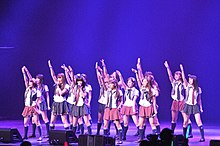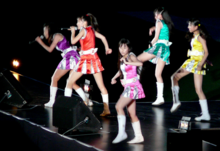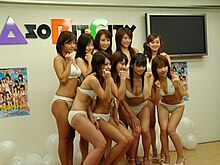Japanese idol

An idol ( Japanese ア イ ド ル , aidoru ) is a person in Japan who, mainly because of his appearance, enjoys great popularity, although not necessarily nationally, but sometimes also regionally. This article deals with the specifically Japanese form of the “ asterisk ”, which differs from the popular understanding of idol in the context of pop culture in western culture through specific properties and attributions, even if the borrowing of the term aidoru from the English idol falsely identifies an identity suggested in the matter. The concept influenced the development in South Korea , but took a different development, see Korean Idol .
properties
The term Aidoru primarily refers to young women in their twenties who are viewed as kawaii and who gain fame primarily through their appearance and publicity in the mass media. Kawaii literally means pretty or cute, u. U. also with a mostly latent sexual connotation, which, however, rarely goes beyond the characteristic of what is desirable. The Japanese Shōjo culture associates the term kawaii with fundamental aesthetic values that emphasize the ideal image of the woman / daughter / sister with non-sexual connotation in the direction of non-sexual, idealized feminine beauty and including moral values. In particular, the female aidoru / idol is therefore understood and marketed as a representative of this ideal image of the Japanese woman and as a symbol for the conservative moral values of Japanese culture.
Deviating from this, idols with an explicitly erotic connotation, especially erotic models, are referred to as Gravure Idol ( グ ラ ビ ア ア イ ド ル , gurabia aidoru , from English gravure = gravure = gravure process for photos) and porn actresses as AV Idol (from Adult Video ). Male actors like Masahiro Nakai (also Nakai-kun ) from the SMAP group are sometimes referred to as idols (and define themselves by their status as idols), but their prominence is mainly based on their work, for example in the film or music business, and corresponds more to that Common understanding of idol or star in western culture in relation to actors and musicians. Unlike the stars known and established in western culture and also in Japan, Japanese Aidoru / Idol are predominantly female and often as singers and actors in cinema and television ( Tarento ), but also models (in the case of women) for men's magazines such as Freitag and Shūkan Gendai .
history
The Aidoru / Idol phenomenon emerged in the early 1970s and reflected the increasingly wealthy and wealthy Japanese youth who were increasingly focused on material values. Teenage girls, mostly between 14 and 16, began to rise to become stars. Momoe Yamaguchi in particular was a prominent aidoru / idol until she retired from the business to get married in 1980. Aidoru / Idols dominated the pop music scene in the 1980s. This time is known as the "Golden Age of Idols in Japan". In a single year 40 or 50 new Aidoru / Idols could appear, only to disappear from the public eye shortly afterwards. Only a few Aidoru / Idols managed to be present in public for several years and to be marketed in this way, or based on their Aidoru / Idol popularity, a follow-up career e.g. B. in the music business.
A few representatives of the Aidoru / idols of this time, such as Seiko Matsuda , are still popular today. In the 1990s, the influence began Aidoru / Idols to wane, as the music industry more turned the rock musicians and -sängern, rather the music was and for their sales as the appearance of importance the more the spread in western culture understanding of idols corresponded . There was also a trend towards genres such as rap , which were difficult to reconcile with the conventional Japanese sense of beauty symbolized by the Aidoru / idols in accordance with the Shoju culture. However, the Japanese aidoru / idol phenomenon has had a major impact on pop culture in Hong Kong and Taiwan .
Up until the 1980s, female Aidoru / idols were mainly worshiped by male fans, while male idols only addressed a female fan base. However, this division of the fan base by gender has changed since the late 1980s, when female fans began to see the female Aidoru / idols not only as symbols of conservative Japanese ideals of beauty, but also believed that they were the realization of a career path to be pursued for women. It was also during this time that some Aidoru / Idols managed to capitalize on their fame as Aidoru / Idol after leaving the "idol business" and establish themselves outside the entertainment sector. Uno Kanda z. B. was able to successfully establish herself as a designer with her own fashion brand, while others opened restaurants or shops.
The female fans increasingly saw the Aidoru / Idols as women who, on behalf of other women, achieved wealth and success in the Japanese society, which is still dominated by patriarchy. They were therefore soon worshiped by both men and women. While they mostly serve the female fans as a projection surface for their own wishes and hopes and as role models to emulate, the enthusiasm of the male audience is mostly limited to detailed information on body measurements, favorite colors, diet, hobbies, blood type , etc. The female audience imitates their style, hair color, clothing, etc. Good examples of idols as role models in matters of fashion are Ayumi Hamasaki , Noriko Sakai , Ryōko Hirosue and Namie Amuro .
Namie Amuro was the most popular pop idol of the late 1990s but was marketed as sexier and more mature than other idols. She began her career in 1992 as a singer for the group Super Monkeys , but the group quickly flopped. For Amuro, however, the producers still saw opportunities on the music market and in 1995 she actually managed to start a solo career with great success. One of their current CDs, Sweet 19 Blues , has pre-sold 3 million copies and was the best-selling album in Japanese history. That number has since been surpassed only by Ayumi Hamasaki and Hikaru Utada .
The market diversified in the 1990s. Instead of a few idols fighting for popularity, a number of idols with specific characteristics divided the market. By the mid-1990s, idols were getting much younger than before, and groups like Speed and Morning Musume became predominant. A new genre of idols, the web-only web idols , emerged in the late 1990s. In 1997, Kyoko Date , the first "cyberidol" or "virtual idol" appeared. Kyoko Date has a made up story and statistics and its own songs. Meanwhile, show Gravure Idols like Yoko Matsugane , Rio Natsume and Eiko Koike mostly scantily clad in pin-up -photos, some like Akira Fubuki , Natsuko Tohno and Sora Aoi also naked.
In the past, an idol had to maintain its image until it withdrew of its own free will or was too old to be a credible idol. In recent years, however, some idols have developed into well-known actresses, singers and musicians.
Culture
The culture of Japanese idols has changed over the years and it is questionable whether idols of the past would have the same success today. Most of the idols have sung songs from the J-Pop genre and have been belittled .
In the 1970s, the agencies and managers of the Aidoru / Idols tried to keep the private life of their protégés as secret as possible and thus give them a mystical aura. Their public and supposedly "private" lives were carefully staged - they always appeared perfect in all situations and seemed to enjoy a lavish lifestyle that most Japanese could only dream of. In reality, however, they were under constant surveillance by their marketers and could not even enjoy the "private life" they made up for them. The "clean" image of the Aidoru / Idols was honed down to the smallest detail and so it happened, for example, that members of the 52-strong idol pop group Onyanko Club , the most successful idol pop group of the 1980s, left the band Thrown for smoking or having a boyfriend.
Onyanko Club is also a good example of the kawaii concept behind the idol bands. Here, too, lay people without vocal training were specifically admitted, whose sometimes inadequate singing talent in some girls should only make them appear even cuter. Their pay was surprisingly low. They were often overworked. Even if their songs sold well, most of the money went to the musicians and songwriters. Fans had little opportunity to see her on TV or radio outside of the few minutes, so it was difficult to share her interests. Magazines were the best source of information and many idols had official fan clubs who regularly passed what little information there was to fans.
In the 1980s, the idols became much closer to the average Japanese as the average Japanese lifestyle improved. Though still closely monitored, the idols were allowed to show more of their real personalities and display some carefully rehearsed outbursts. The media often organized "competitions" between two or more idols for things like the number of records sold, the number of members in the official fan club, etc.
In the late 1980s, instead of relying on magazines and television, some experiments with new media and technologies, such as video games, were launched with mixed results. The working conditions of the idols improved and even idols with limited success could live a modest or better life, although even today they receive only a small fraction of the money that is made with them.
In the 1990s, instead of being marketed as people who lived better and were better than the average, idols became people who had that "something" to become popular. While the taste of the idols of the past must have been sugary sweet, it was now acceptable for an idol to enjoy ramen or express something other than a smile, e.g. B. to lament, to be a little out of shape or to admit to looking for low prices on a shopping spree.
However, the public appearances of Aidoru / Idols are still heavily staged, just like their background story is tailored to demand and created accordingly. This becomes particularly clear in the casting band AKB48 , a singing group from Tokyo, which actually consists of three groups, whose nominal strength consists of 48 girls each (although not always close to). While the number “48” refers to the nominal strength of the group, “AKB” is an abbreviation for the Tokyo district of Akihabara, which is known for technology and otaku culture . The individual groups running under the label "AKB48" take turns performing in evening performances in Akihabara and presenting their songs with rehearsed group dance choreography, previously tailored by producers and lyricists to suit current musical tastes. In addition to the appearances, members of the group present videos, CDs and general publications under the label "AKB48", open department stores and appear in strictly prescribed costumes. By using several groups under a common name, it is possible to give live concerts almost every day and perform at different locations at the same time.
Idols have also become a fixture in the countless anime , in which they sing opening and closing songs that often have little to do with the content of the anime as such. In addition, some idols tried their hand at voice acting ( seiyū ) in anime.
theory
Hiroshi Aoyagi, Associate Professor of Cultural Anthropology at Kokushikan University , believes that the Japanese idols are the modern version of the geisha . The main task of the geisha was to personify the ideal image of female beauty in traditional Japan in the stylized artistic interpretation. He also draws parallels with ritual practices in other cultures. While traditional institutions collapse as a result of modernization and industrialization, Aoyagi said, the mass media increasingly fulfilled this function. The teen idols known all over Japan actually played an important role in depicting and representing the audience's culture.
literature
- Hiroshi Aoyagi: Islands of Eight Million Smiles. Idol Performance and Symbolic Production in Contemporary Japan . Harvard University Press, 2005, ISBN 978-0-674-01773-3
- Timothy J. Craig: Japan pop! - Inside the world of Japanese popular culture , New York 2000.
- Shuhei Hosokawa: Popular Entertainment and the Music Industry. In: Jennifer Ellen Robertson (Ed.): A companion of the anthropology of Japan. Blackwell publishing 2005, pp. 297-313.
- Masako Itō: I'm married to your company! - Everyday voices of Japanese women. Maryland / USA, Plymouth / UK 2008.
- Kōichi Iwabuchi: Recentering globalization. Popular culture and Japanese transnationalism. Duke University Press 2002.
- Dani Madrid Morales, Guillermo Martinez: El manga i l'animació japonesa. Barcelona 2010
Individual evidence
- ↑ も も ク ロ 、 初 の AKB 超 え タ レ ン ト パ ワ ー ラ ン キ ン グ ( yes ) Nihon Keizai Shimbun . June 24, 2013. Retrieved December 10, 2013.
- ↑ Colette Balman : Introduction to Japanese horror film. Edinburgh 2008, p. 122.
- ↑ a b "Golden age of idols" Minoru Matsutani: Pop 'idol' phenomenon fades into dispersion. The Japan Times Online October 25, 2009.
- ↑ On idols in the 1980s see also Kōichi Iwabuchi: Recentering globalization. Popular culture and Japanese transnationalism. Duke University Press 2002, p. 113.
- ↑ Christine Reiko Yano: Tears of Longing: Nostalgia and the Nation in Japanese Popular Song. Harvard 2002, p. 214.
- ^ Shuhei Hosokawa: Popular Entertainment and the Music Industry. In: Jennifer Ellen Robertson (Ed.): A companion of the anthropology of Japan. Blackwell publishing 2005, pp. 297-313, here pp. 308f.
- ↑ For the image of the idols staged by others, see Timothy J. Craig: Japan pop! - Inside the world of Japanese popular culture , New York 2000, p. 312.
- ↑ cf. u. a. Mark Schilling: The Encyclopedia of Japanese pop culture. Weatherhill, 1997, p. 166.
- ↑ Kim Cooper, David Smay, Jake Austen: Bubblegum music is the naked truth. Feral House 2001, p. 179.
- ↑ Hiroki Azuma, Jonathan E. Abel: Otaku: Japan's database animals. Minnesota 2009, p. 131.
- ↑ Onyonoko Club
- ↑ See also Neomarxisme, March 16, 2005 ( Memento of the original from September 15, 2010 in the Internet Archive ) Info: The archive link was inserted automatically and has not yet been checked. Please check the original and archive link according to the instructions and then remove this notice.
- ↑ For “Aidoru” and “AKB48”, see Dani Madrid Morales, Guillermo Martinez: El manga i l'animació japonesa. Barcelona 2010, p. 70.
- ↑ Christine Hoff: Justification for Anime Fandom. December 11, 2000, accessed February 25, 2009 .


